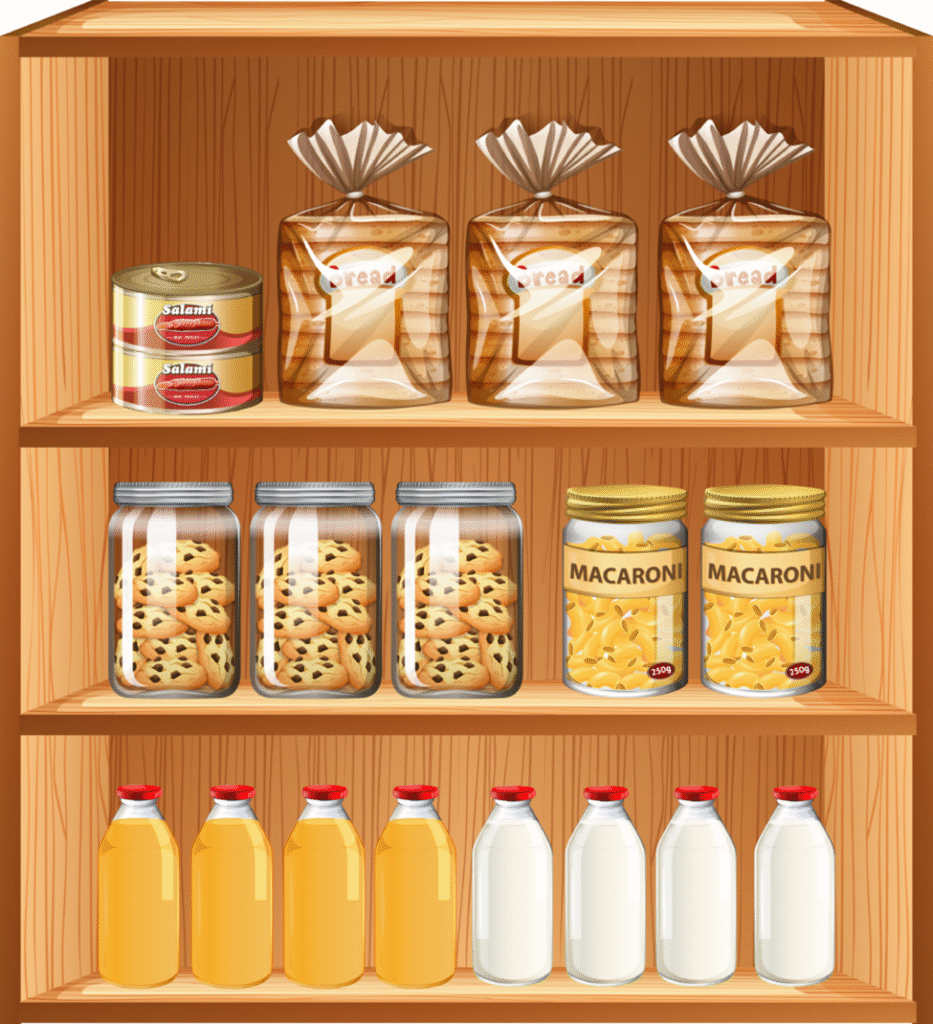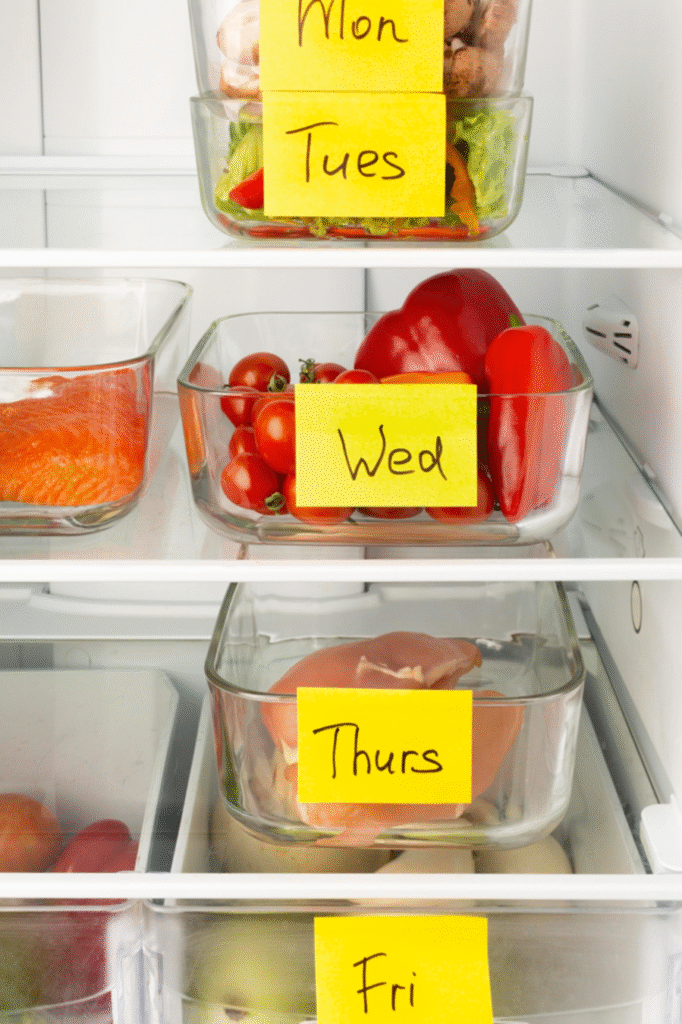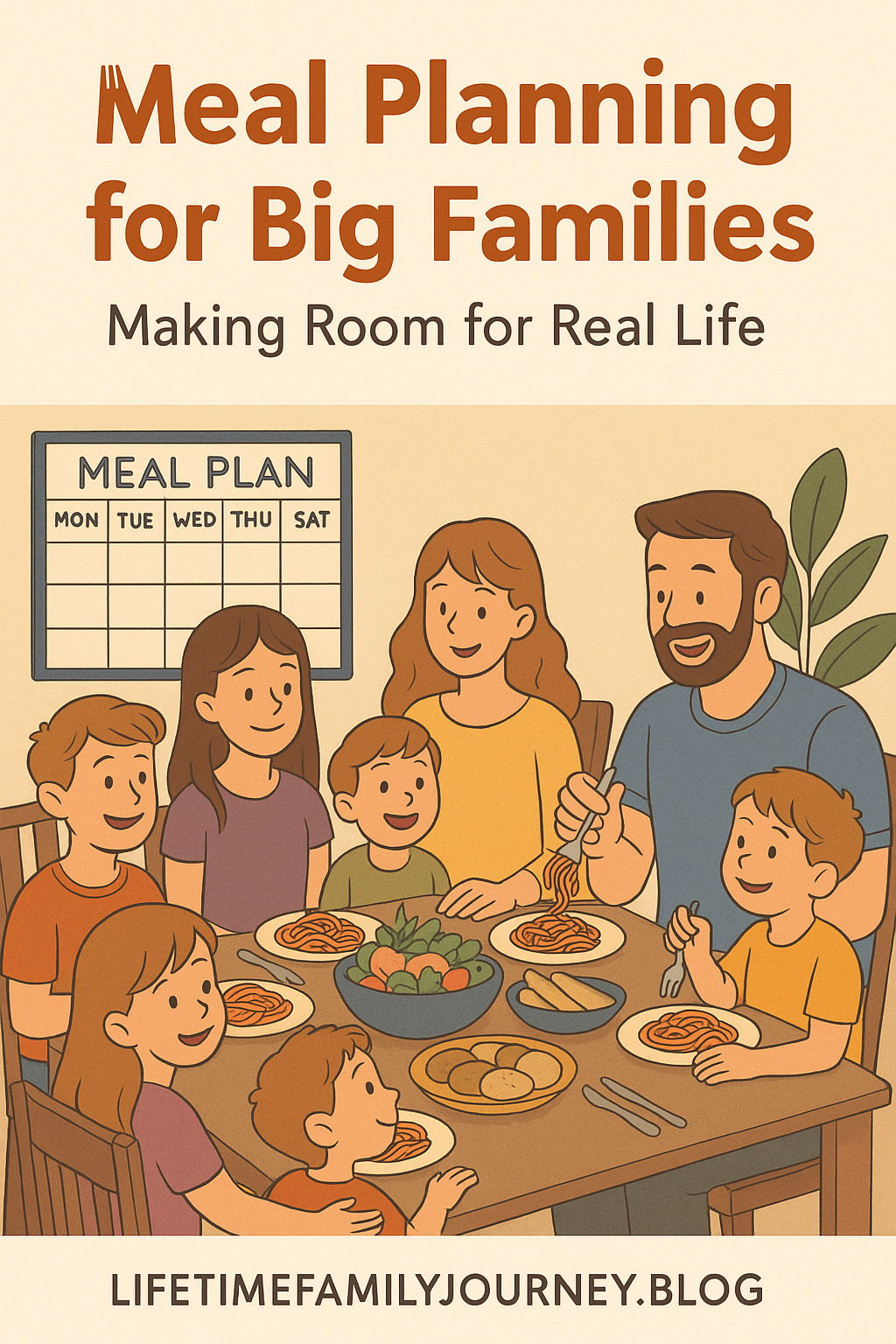Meal Planning for Big Families: Making Room for Real Life

It’s 5:30 PM on a Tuesday. Six hungry kids are circling the kitchen like sharks. Your spouse walks in, drained from the day. And you? You’re staring into the fridge like it just betrayed you—because somehow, the leftovers you were counting on have vanished into thin air. Sound familiar?
After twenty years of marriage and raising six kids (five daughters who could eat a linebacker under the table and one son who somehow survives on air and attitude), I’ve learned that meal planning for big families isn’t about achieving Pinterest-perfect organization. It’s about creating sustainable systems that work even when life gets messy.
This comprehensive guide to meal planning for big families will show you exactly how to feed your crew without breaking your budget or losing your mind in the process.
And trust me, life with eight people under one roof gets really messy.
Let me share what I’ve discovered about feeding a big family on a budget without losing your sanity, breaking your bank account, or sacrificing family connection in the process.
Why Meal Planning for Big Families Actually Matters 🏡👨👩👧👦

Designed by Freepik
Let’s be brutally honest here—feeding a large family can feel like running a short-order restaurant where the customers are never satisfied and the reviews are always harsh. But here’s the thing: meal planning for big families isn’t about adding another item to your overwhelming to-do list. It’s about removing the daily stress of “what’s for dinner?”
When our family first started growing (and growing… and growing), I thought I could wing it. Just hit the grocery store whenever we ran out of food, figure out dinner on the fly, maybe grab takeout when things got crazy. That lasted about three weeks before I realized we were hemorrhaging money and I was developing a nervous tick every time someone asked about food.
A solid meal plan becomes your secret weapon against food waste, impulse grocery purchases, and the dreaded 6 PM panic. It also creates natural opportunities to teach kids responsibility—yes, even the toddler can help stir something or set napkins on the table.
The real magic happens when you build flexibility into your structure. Think of it like jazz music: you need the basic rhythm and chord progression, but there’s room for improvisation when life throws you a curveball.
Benefits that actually matter:
- Reduces mental load because the decision is already made
- Saves significant money by eliminating impulse buys and reducing food waste
- Creates teaching moments for kids about nutrition, budgeting, and life skills
- Builds family connection through shared preparation and meaningful mealtimes
Build Your Weekly Plan Around Themes 🗓️🍝
Here’s where most meal planning for big families advice falls apart: it assumes you have endless creativity and time to come up with seven unique dinners every week. That’s not realistic when you’re already managing school schedules, work demands, and the chaos that comes with a full house.
Theme nights are your friend. They provide structure without requiring you to reinvent the wheel every Sunday. More importantly, they help with grocery shopping because you know exactly what categories of ingredients you’ll need for your large family dinner ideas.
Here’s what works in our house:
Monday: One-Pot or Instant Pot Night – Because nobody wants to wash fifteen dishes on Monday evening. Think chili, soup, or anything that cooks in one vessel.
Tuesday: Taco Tuesday or Mexican-Inspired – Kids love the predictability, and you can use up random vegetables hiding in your crisper drawer.
Wednesday: Pasta Night – Carbs make everyone happy, and you can stretch budget-friendly family meals into satisfying portions.
Thursday: Leftovers or “Clean-Out-the-Fridge” Night – This prevents food waste and gives you a break from cooking.
Friday: Family Favorite Night – Pizza, meatloaf, whatever makes your crew smile after a long week.
Saturday: Soup and Bread or Sandwich Night – Perfect for using up odds and ends, plus it feels cozy.
Sunday: Big Meal or Casserole Day – Time for meal prep and that one impressive dish that creates amazing leftovers.
The beauty of this system? Older kids can start helping with meal preparation because they know what to expect. My fifteen-year-old can now handle Taco Tuesday almost entirely on her own.
Pro tip: Post your weekly meal plan somewhere visible. Add little pictures or emojis for younger kids who can’t read yet. It cuts down on the “what’s for dinner?” questions by about 90%.

Budget-Friendly Staples That Actually Stretch 🛒💰
Let’s talk money, because feeding a big family on a budget isn’t exactly cheap. The grocery budget can quickly become the thing that breaks your monthly finances if you’re not strategic about it.
The secret isn’t buying the cheapest ingredients—it’s learning which affordable staples can transform into multiple different meals. I call these my “chameleon ingredients” because they can change identity depending on what else you pair them with.
Essential staples that earn their keep:
Rice, potatoes, and pasta – These carbohydrate foundations can support almost any protein and vegetable combination while making everyone feel full and satisfied.
Ground turkey, chicken thighs, or bulk sausage – Less expensive than premium cuts but incredibly versatile. Ground turkey can become tacos, pasta sauce, or stuffed peppers. Chicken thighs are cheaper than breasts but actually taste better in most budget-friendly family meals.
Canned beans, lentils, and frozen vegetables – Protein and nutrition that won’t spoil before you use them. Beans can stretch meat dishes or replace meat entirely without anyone feeling deprived.
Eggs, oats, peanut butter, and flour – Breakfast ingredients that can also solve dinner problems. Breakfast-for-dinner is a crowd-pleaser, and homemade bread or pancakes can turn a thin meal into something satisfying.
Bananas, apples, and seasonal produce – Fruits that kids actually eat and vegetables that are affordable year-round.
The magic happens when you realize these ingredients can create dozens of different meals. Chicken thighs become stir-fry one night, soup another night, and tacos the next. Rice can be Spanish rice, fried rice, or rice and beans. Same ingredients, completely different large family dinner ideas.
Money-saving strategy: Create a “Staple Swap List” for when you run out of something mid-week. Lentils instead of ground beef, frozen broccoli instead of fresh, rice instead of pasta. Flexibility saves both money and stress.

Getting Everyone Involved (Yes, Even the Little Ones) 👩🍳👧🧑🍳

One of the biggest mistakes I made early on was thinking I had to handle all the kitchen responsibilities myself. Big families can’t function with one person carrying the entire food load.
The truth is, involving kids in family meal prep strategies and food preparation builds essential life skills while lightening your workload. These meal planning for busy families techniques work because everyone has a role. Start with age-appropriate tasks and gradually increase responsibility as they grow.
Age-appropriate kitchen roles:
Ages 3-5: Stirring ingredients, pouring measured items, setting napkins on the table, sorting utensils
Ages 6-8: Washing vegetables, measuring ingredients, making sandwiches, loading dishwasher
Ages 9-12: Chopping vegetables (with supervision), following simple recipes, planning one meal per week
Ages 13+: Taking responsibility for entire meals, grocery shopping with a list, teaching younger siblings
The key is making it feel like privilege rather than chore. We have a “Kitchen Boss” rotation where each kid gets to be the head chef for one meal per week (within reasonable budget boundaries). They plan it, shop for special ingredients if needed, and direct the cooking process.
This approach has multiple benefits: Kids are more likely to eat food they helped prepare, they learn valuable life skills, and you get help with the daily grind. Plus, cooking together creates natural opportunities for conversation and connection that don’t happen when everyone’s scattered doing their own thing.
Some of our best family memories happen during chaotic cooking sessions where someone inevitably spills something and we all laugh until our stomachs hurt.
Master the Leftover Game ♻️🥘

If you’re not strategically planning for leftovers, you’re missing one of the biggest budget and time-saving opportunities available when meal planning for big families. The goal is to cook once and eat twice (or more).
Doubling recipes doesn’t take double the effort, but it gives you a massive head start on a future meal. The trick is repurposing leftovers so they don’t feel like the same meal repeated. This is where family meal prep strategies really shine.
Leftover transformation strategies:
Roast chicken becomes chicken tacos, chicken salad sandwiches, or chicken soup
Spaghetti sauce turns into pizza sauce, lasagna filling, or base for chili
Rice transforms into fried rice, stuffed peppers, or breakfast rice pudding
Meatloaf becomes meatball subs or crumbled into pasta sauce
The secret is planning these transformations from the beginning. When I’m making roast chicken, I’m already thinking about Tuesday’s tacos. When I’m making extra rice, Wednesday’s fried rice is practically guaranteed.
Create a “Leftover Buffet Night” once a week where everyone can choose what they want from the refrigerator options. Kids love the autonomy, and you love clearing out the fridge. It’s like a restaurant where everything is already paid for.
Storage and labeling matter. Invest in quality containers and actually label things with dates. Nothing kills leftover enthusiasm like mystery food that might be three days or three weeks old.
For busy families dealing with easy dinner ideas for large families, strategic leftovers can be the difference between a relaxed evening and takeout panic.
Shop Smarter, Not Harder 🧾🛍️

Smart grocery shopping for large families starts before you leave the house. A detailed list based on your weekly meal plan isn’t just helpful—it’s essential for staying on budget and avoiding multiple mid-week emergency trips.
First, shop your own pantry and freezer. You’d be amazed how often we buy duplicates of things we already have because nobody checked what was actually available. This five-minute check before making your list can save significant money when feeding a big family on a budget.
Strategic shopping tactics that work:
Buy in bulk for frequently used items like rice, beans, flour, and oats. The per-unit cost drops significantly, and these ingredients store well long-term.
Watch sales cycles for proteins and stock up when prices drop. We buy several packages of ground turkey when it goes on sale and freeze what we won’t use immediately.
Choose store brands for basic ingredients. The flour, sugar, and canned goods are virtually identical to name brands but cost significantly less.
Shop early in the day to get markdowns on meat and produce that’s near its sell-by date. These items are perfectly good but discounted because stores need to move them quickly.
Consider grocery pickup or delivery if it’s available in your area. Yes, there might be a small fee, but you’ll stay exactly on budget because you can’t impulse-buy when you’re not physically in the store. Plus, you avoid the “can we get this?” negotiations with kids.
Timing matters for your sanity. Shopping alone (if possible) is faster and less stressful than managing kids while trying to stay focused on your list. If you must bring kids, assign each one a specific job to keep them engaged.
The families I know who successfully manage their grocery budgets treat shopping like a strategic mission rather than a casual errand. They have their list, they know their budget, and they stick to both.
Cook Once, Eat All Week (The Power of Batch Cooking) 🍱📆

Batch cooking might sound intimidating, but it’s really just strategic cooking that sets you up for success during busy weeknight hours. Pick one or two days per week to prep components that can be assembled into quick meals later.
This is where effective family meal prep strategies make the biggest difference. The goal isn’t to cook entire meals ahead of time (although you can). Instead, prepare the building blocks that make weeknight cooking faster and easier when meal planning for big families.
Batch cooking components that make a difference:
Proteins: Cook several pounds of ground turkey, chicken, or beef and portion into meal-sized containers. These can become tacos, pasta sauce, soup base, or casserole fillings throughout the week.
Grains: Make large batches of rice, quinoa, or pasta. Store properly portioned amounts that can be quickly reheated as needed.
Vegetables: Wash, chop, and store vegetables for the week. Having carrots, celery, onions, and peppers ready to go eliminates a major prep step from busy evenings.
Sauces and bases: Make large batches of tomato sauce, curry base, or soup stock that can be used in multiple different budget-friendly family meals.
Breakfast items: Prepare overnight oats, egg muffins, or pancake batter that can be quickly finished in the mornings.
Freezer meals: Assemble complete meals that can be dumped into the slow cooker. Rotate these into your weekly plan so you always have a backup option.
The magic happens when you can come home on a Wednesday evening and assemble dinner in fifteen minutes using components you prepared on Sunday. It’s like having a personal meal kit service, except it costs a fraction of the price and uses ingredients your family actually likes.
Successful family routines that work often include some form of batch cooking because it removes decision fatigue and time pressure from busy weeknights.
Advanced Meal Planning for Big Families Strategies 📋⚡

Once you’ve mastered the basics, there are advanced techniques that can take your meal planning for big families to the next level. These strategies work especially well when you’re feeding a big family on a budget and need maximum efficiency.
The “Ingredient Bridge” Method: Plan meals that share ingredients across multiple days. If you buy a large package of ground beef, use it for tacos Monday, spaghetti sauce Wednesday, and meatloaf Friday. This reduces waste and maximizes bulk buying savings.
Seasonal Menu Rotation: Create four different monthly meal plans based on seasons. Spring might feature more fresh vegetables and lighter meals, while winter focuses on hearty soups and casseroles. This keeps things interesting while taking advantage of seasonal pricing.
The “Prep Day Power Hour”: Dedicate one hour every Sunday to washing vegetables, portioning snacks, and preparing grab-and-go breakfast items. This single hour saves countless minutes throughout the week.
Emergency Meal Kits: Assemble three different “emergency meals” in your pantry using shelf-stable ingredients. Label them clearly and resist the temptation to use them unless it’s truly an emergency. These become your backup when everything else falls through.
Building Flexibility Into Your System 🔄
The most successful meal planning for big families systems are the ones that bend without breaking. Life with multiple children means constant schedule changes, unexpected events, and days when nothing goes according to plan.
Build in natural swap points. If Tuesday’s meal requires more prep time than you have available, it should be easy to swap with Thursday’s simpler option. Design your weekly menu so that at least two meals can be switched around without affecting your grocery list.
Create “difficulty levels” for your meals. Have some meals that require minimal effort (think crockpot dump meals), some that need moderate preparation, and one or two that are more involved. On crazy weeks, lean heavily on the easy options.
Master the art of substitution. When you run out of an ingredient mid-week, know what can replace it. No ground beef? Use lentils or beans. No fresh vegetables? Frozen works just fine. No energy to cook? That’s what your freezer meal stash is for.
This flexibility prevents the all-or-nothing mentality that kills most meal planning attempts. Some weeks you’ll execute your plan flawlessly. Other weeks you’ll use every backup strategy you have. Both outcomes are successful as long as your family is fed.
Teaching Kids Real-World Skills Through Food 🎓👨🍳
One of the unexpected benefits of meal planning for big families is the opportunity to teach children practical life skills they’ll use forever. These lessons go far beyond just cooking techniques.
Math skills happen naturally when kids help measure ingredients, calculate serving sizes, or figure out grocery budgets. My eight-year-old can tell you exactly how much rice we need for our family and what it costs per serving.
Time management becomes essential when multiple kids are helping with meal prep. They learn to work backwards from dinner time, understand how long different tasks take, and coordinate with siblings.
Financial literacy develops when kids see how food choices affect the family budget. They begin to understand the difference between wants and needs, and why we choose store brands for some items but splurge on others.
Problem-solving skills emerge when ingredients are missing or recipes don’t work as expected. Kids learn to adapt, substitute, and make the best of imperfect situations.
These skills serve them well beyond the kitchen. The child who can plan a meal, stay within budget, and adapt when things go wrong is developing life competencies that will benefit them forever.
Give Yourself Grace and Keep Going 💛🙏
Here’s the truth nobody talks about in meal planning for big families articles: No system is perfect, and life will absolutely mess up your plans.
Someone gets sick. A work emergency happens. The power goes out right before dinner. You completely forget to defrost anything and suddenly it’s 6 PM with no plan whatsoever.
This is normal. This is real life with a big family.
The goal isn’t perfection—it’s consistency over time. Having a plan that works 70% of the time is infinitely better than having no plan at all. Those 30% chaos nights? They’re going to happen regardless, so don’t let them derail your entire system.
Grace-giving strategies:
Keep backup meals in your pantry – mac and cheese, rice and beans, breakfast for dinner. These aren’t failure meals; they’re insurance policies.
Build flexibility into your plan – if Thursday’s meal doesn’t happen, move it to Friday and have the backup instead.
Celebrate small wins – a week under budget, successfully involving kids in cooking, or just getting everyone fed without major drama.
Remember your why – you’re not just feeding bodies, you’re creating memories, building relationships, and modeling life skills for your children.
Some of our family’s best memories come from the nights when everything went wrong and we ended up laughing together over cereal for dinner or building blanket forts while waiting for pizza delivery.
Meal planning for big families is about progress, not perfection. Start with planning just three dinners per week if that feels manageable. Add more structure as it becomes habit. The consistency you build over time matters far more than any single challenging day.
Your family needs you to be sustainable more than they need you to be perfect. Give yourself the same grace you’d offer a friend facing the same challenges.
Creating Food Memories That Last
At the end of the day, meal planning for big families isn’t really about the food—it’s about the people gathered around the table. It’s about teaching your kids that they’re worth the effort of planning and preparing nourishing meals. It’s about creating rhythms that anchor your family when everything else feels chaotic.
Some of my children’s favorite memories involve cooking disasters that we turned into adventures. The time we accidentally made “soup” that was thick enough to eat with a fork. The evening we let everyone design their own pizza and ended up with creations that belonged in an art museum. The Sunday mornings when we made pancakes shaped like animals and ended up with flour in our hair and laughter in our hearts.
These moments don’t happen by accident—they happen because we show up consistently, make space for connection, and approach family meals with intention rather than obligation.
Your family meal prep strategies don’t need to look like anyone else’s. They need to work for your family, your budget, your schedule, and your sanity. Start where you are, use what you have, and adjust as you learn what works.
The goal isn’t to impress anyone or achieve some impossible standard. The goal is to feed your people well while creating an atmosphere of love, connection, and grace around your family table.
Because at the end of the day, they won’t remember every meal you served—but they will remember how it felt to be part of a family that prioritizes being together.
Looking for more practical large family wisdom? Check out our family morning routines that actually work or discover creative ways to repurpose leftovers that will revolutionize your kitchen efficiency.
🌐 Explore More from Our Family of Blogs
If you found this article helpful, you might also enjoy what we’re sharing across our other platforms. Each one is designed to uplift, equip, and inspire families in real, practical ways:
🏠 Mountains Will Move
Faith-based encouragement for everyday families. We dive into prayer, parenting, purpose, and pressing through life’s hardest seasons with Jesus at the center. 👉 Visit Mountains Will Move »
🔎 Everyday Exposed
Our no-filter truth hub—where we tackle myths, challenge misleading narratives, and bring clarity to the conversations that matter most. 👉 Visit Everyday Exposed »
Whether you’re diving deeper into family life, faith, or uncovering truth in today’s noisy world, I hope you’ll journey with us.
Thank you for being part of the community. 🙏
